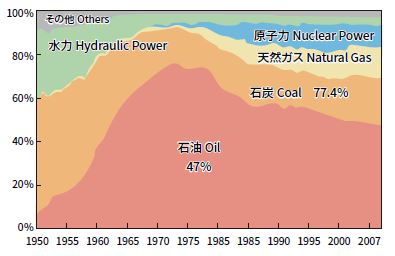Japan to set sail for full-scale peace diplomacy to the Middle East (1)
NPO Salaam Association Chairman Ikuzo Kobayashi
From the Spring Issue of the electronic “Salaam Quarterly Bulletin”, No.32, March 2020
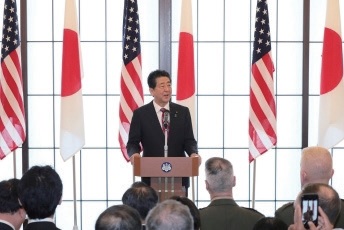
Last year Japan changed the era name from Heisei to Reiwa and entered a new era. Seven years ago, the second administration of Abe launched “proactive contribution to peace” diplomacy and Prime Minister Shinzo Abe visited the Middle East first. The achievement of last year’s summit meeting with Iran can be seen as a result of his diplomatic efforts. It was President Trump who hoped Japan to play a role through peace diplomacy in the intensifying conflict between Iran and the United States. It is also the 60th anniversary of the conclusion of the Japan-US Security Treaty, which can be said to be the result of the unwavering deepening and development of the US-Japan Alliance.
I would like to make suggestions on Japan’s involvement in the Middle East in this issue and the next issue.
U.S. –Japan Security Treaty and Japan’s crude oil acquisition
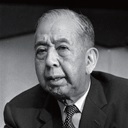
Prime Minister Kishi, who visited the United States in January 1960, led an all-government delegation, met with then-President Eisenhower and signed the new Security Treaty.
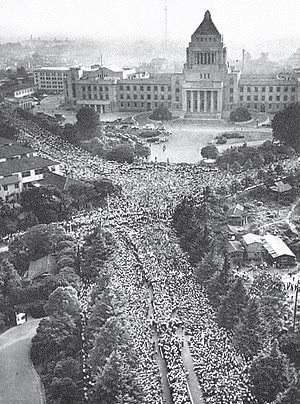
Protesters surrounding the Diet, June 18, 1960. From Wikipedia
Now that Japan has been recognized as a peaceful nation, its starting point can be traced back to the conclusion of the new US-Japan Security Treaty. The left-wing faction, rooted in communist ideology, argued that if Japan and the United States sign the security treaty, Japan would be caught up in a war again. The mass media went along with this argument and amplified the voice for anti-Security Treat struggles through relentless reporting.
After World War II, the conflict between the U.S.-Europe liberal democracy camp and the communism camp resulted in the division of the People’s Republic of China and the Republic of China (Taiwan) and the division of North and South Korea in Asia, and the global conflict between democracy and communism escalated. Japan, which regained its sovereignty through the San Francisco Peace Treaty in September 1951, has been positioned as an “anti-communism fort” by the US-Japan Security Treaty, which came into effect with the signing. The approval of the new US-Japan Security Treaty by the Kishi Cabinet in 1960 determined the position of Japan as a member of the democracy camp as an expression of national will.
On the other hand, in postwar era, Japan followed the path of a trading nation. It was essential for Japan to import crude oil, an energy resource that is the basis of the industrial economy. Since relying solely on imports made Japan uneasy, self-developed oil fields were recognized as Japan’s national policy priority. In 1958, an oil development agreement was signed between Japan and Saudi Arabia as well as Kuwait.
Persian Gulf oil that contributed to the great development of the Japanese economy

The launch of this oil field miraculously developed by Japan has opened up new ties between the Persian Gulf States and Japan. Arab Oil successfully fulfilled its mission of supplying crude oil to Japan. The stable supply of cheap oil has revolutionized power and electricity sources. Gasoline, heavy oil, light oil necessary for power sources of cars, ships, and airplanes can now be supplied at a price commensurate with the cost. Thermal power generation replaced hydraulic power generation as the mainstream source of electricity supply.
Furthermore, as shown in the figures below, among the gasoline obtained by distilling crude oil, light gasoline “naphtha” with a relatively low boiling point was used as a raw material for petrochemical products, and ethylene, benzene, etc. were extracted and used for manufacturing of plastics, synthetic resin, synthetic rubber, face wash raw materials and coating raw materials. The development of the petrochemical industry enabled production of all kinds of necessities of life.

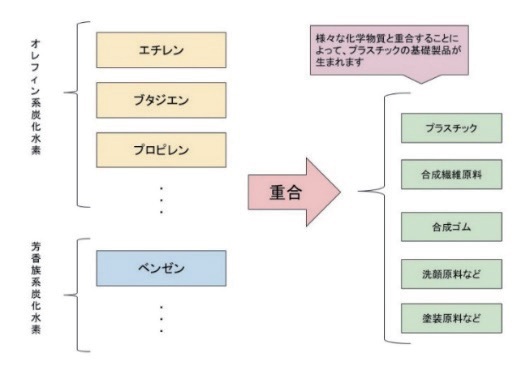
Bonds between Japan and the Gulf countries
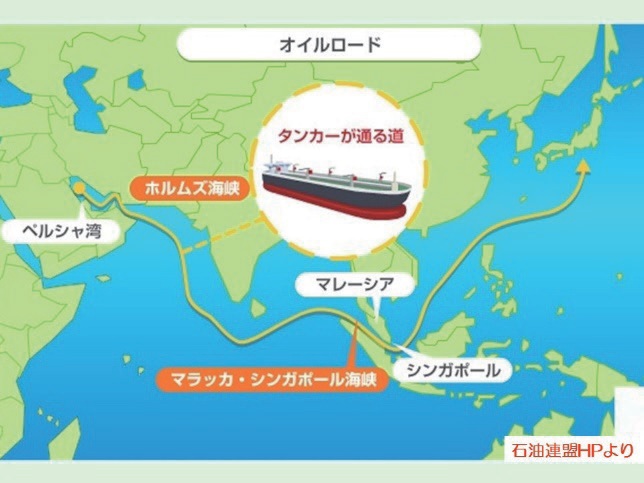
Ancient silk road of the sea dramatically evolved into oil road.
The import of cheap Middle Eastern crude oil has brought about the development of the Japanese industry and has become the cornerstone of the rapid growth of the Japanese economy. The relationship between Japan and the Gulf countries, which was linked by the precious oil trade, whose value was expressed by a phrase “a drop of oil is a drop of blood”, was naturally progressing well.
The recognition that the Middle East Gulf countries are moderate pro-Western countries and that friendship with Japan is deepening has become Japan’s common sense about the Middle East. However, there was another reality in the Gulf countries which the Japanese general public could not see. Certainly, the Gulf countries are pro-Western, but they are also Muslim. Therefore, they could not tolerate a group of Christian nations that tended to side with Israel, even if they would not join the atheistic communism camp. In particular, the Gulf countries had sided with Palestine which was allied with the Arab in the Middle East War fought with the ‘Arab cause’ since the independence of Israel.
From that perspective, Japan was indirectly placed on Israel’s side by the U.S.-Japan Security Treaty, and at the same time was the most friendly oil importer. In fact, Japan was Kuwait’s largest oil importing customer at that time.
First oil shock
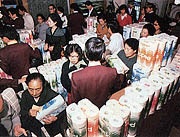
People rushing to buy daily necessities due to oil shock
In 1973 Egypt and Syria initiated a surprise attack on the Israeli army. Egypt reclaimed the Sinai Peninsula and Syria reclaimed the Golan Heights from Israel. Egypt and Syria were in advantage in the opening battle but the situation changed with Israel’s counterattack. To support the struggle, Arab countries have adopted an oil strategy. The Organization of Arab Petroleum Exporting Countries (OAPEC), an Arab oil-producing organization, has decided to reduce total crude oil production by 5% each month from the previous month. The six Gulf States have decided to raise their published oil prices by 70%. OAPEC has also decided to suspend oil exports to countries that are friendly to Israel. (The fourth Middle East war entered cease fire on October 23. This oil strategy was set to end in the spring of next year.)
Development of non-petroleum alternative energy
■ Composition of the total supply of primary energy
Source: Agency of Natural Resources and Energy “Comprehensive Energy Statistics”
Institute of Energy Economics of Japan “Energy Economic Statistics Outline
Note that a method different from the current one was used for the Comprehensive Energy Statistics prior to Fiscal Year 1990. Calendar Year was used prior to 1953.
The world economy fell into recession due to a drastic increase in crude oil prices. Japan was seriously worried about how to overcome this situation and launched an energy mix policy. The policy included (1) diversification of energy sources (from oil to natural gas and nuclear power) (2) regional diversification of the source of crude oil imports (diversification from concentration in the Middle East).
As shown in the above figure, the energy mix policy worked effectively, and the share of oil in energy sources reached the peak with 77.4% in 1973, and then declined to 47.0% in 2007.
The Iranian Islamic Revolution took place in January 1979, and the second oil shock was feared with expected termination of Iran’s crude oil production. The surge in oil prices inside OPEC has caused a severe drop in oil demand, and with the offensive of non-OPEC oil-producing countries in the form of increased oil production, the OPEC cartel collapsed.
Japanese dual diplomacy enabled on the foundation of peace in the Middle East
In the context of the East-West Cold War, Japanese diplomacy based on the US-Japan Security Treaty was naturally aligned with the US and European democracy camps. Japan has become a friendly nation with Israel in the security area. On the other hand, through crude oil production and oil trade, Japan has established friendly relations with Arab and Gulf countries. For Japan, Arabs and Israel are both friends. But from the perspective of Arabs or Israel which are hostile to each other, Japan’s diplomacy appears to be dual diplomacy. Therefore, in order for Japan’s dual diplomacy to be sustainable, cessation of war and mutual peace between Arabs and Israel is a prerequisite.
However, it is hard to say that Japan has been actively involved in peace-making in the Middle East even after the oil crisis. From the Middle East’s point of view, Japan still had the negative image of “the country which still suffers aftereffects of the defeat by the United States”, and “the country approaching the Middle East for oil”.
Japan’s contribution to world peace not recognized during the Gulf War

On November 29, the United Nations Security Council adopted the resolution 678 which virtually allowed use of force and all necessary measures to urge Iraq to withdraw from Kuwait with final deadline of January 15, 1991.(November 30, 1990 evening issue of the Chunichi Shimbun)
It was the Gulf War that made me realize that Japan was not playing a role in world peace. Despite a United Nations resolution to liberate Kuwait invaded by Iraq, Japan did not actively support US-British-led multinational forces. More frankly, Japan should have openly expressed its support for the decision that an esoteric situation that could escalate into a world war would only be resolved with the elimination of Iraqi forces by a multinational force. The Japanese government at that time could not deal with the situation seriously, could not overcome the opposition’s argument against the “military solution”, and tried to limit its role to a “financial aid” solution. Criticism from the United States Congress raised the question, “Is Japan’s effort only about money?”
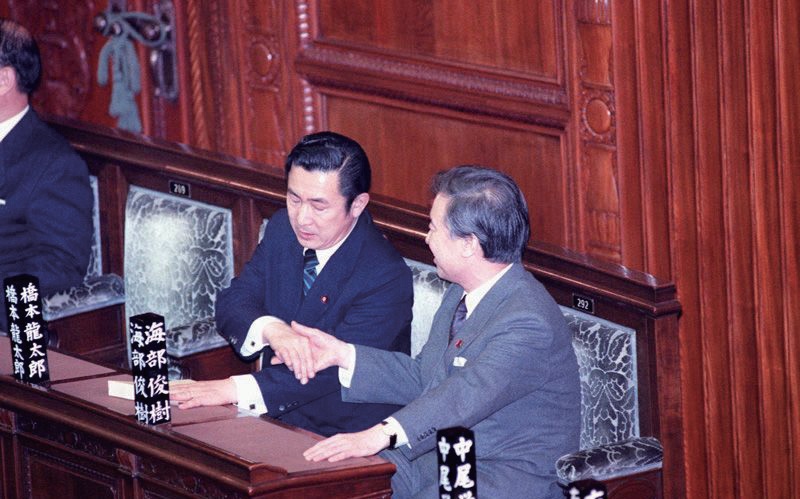
A bill for additional $ 9 billion aid to the multinational forces in the Gulf War has been passed, and Mr. Ryutaro Hashimoto shakes hands with Prime Minister Toshiki Kaifu (right) (February 28, 1991. The reputation of Japan has diminished because of the additional support given out of concern about the discomfort of the United States.)
Japan was called Japan as No. 1 around 1985 but wasn’t Japan able to achieve economic development and global economic power status thanks to the oil supplied by the Gulf countries? What would Japan do when Kuwait is nearing total destruction? Japan naturally felt that something had to be done for that special country. But all Japan could provide was a monetary support. Japan’s contribution to the Gulf War was $ 13 billion. It was paid with the national tax. This amount is 15,000 yen per capita from 120 million Japanese at the rate at that time. No other country contributed as much as Japan did. However, Japan, which was unable to provide human support, received considerable accusations of giving “reluctantly” and “only money”.
Japan’s transformation after the end of the Cold War

Mr. Kaoru Yosano, who served as vice chairman of the House of Representatives’ Diet Affairs Committee in 1991
The Gulf War ended on February 28, 1991. The bill including an additional $ 9 billion in support, approved by the Japanese Diet, was enacted on March 6, 1991. The US Congress has criticized the support as “too late” and “too little”, despite the world’s largest contribution of $ 13 billion in total including $ 4 billion support already funded. The excuse that upper and lower houses of the Japanese Diet at that time was controlled by a different political party and the action was delayed because of that was not accepted overseas.
The late Kaoru Yosano, who took this situation seriously, testified as follows in the Yomiuri Shimbun’s “Testimony of the Times” column on January 2, 2013:
“Even if we struggled that much, after all, just putting out money will cause loss of trust and Japan will become an orphan internationally. While being agonized by such thought, I read an article about the removal of mines by the French special forces in the US weekly magazine Time, which I was reading before going to the bed. As I woke up the next day inspired, I proposed to Mr. Kajiyama, “Let the minesweeper go to the Persian Gulf to remove mines.” … On April 26, the Maritime Self-Defense Force minesweeper and supply ship departed for the Persian Gulf.”
Operation Gulf Dawn
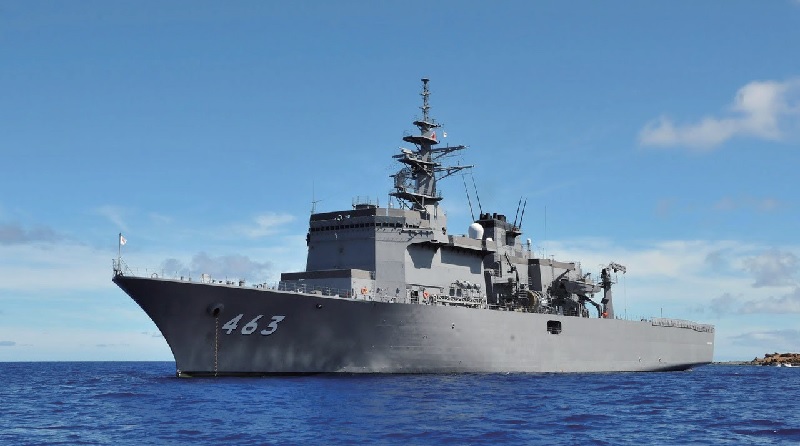
The photo above shows minesweeper carrier Uraga, built for the first time in 25 years since the minesweeper carrier Hayase. The minesweeping technology of the Hayashi era has been reflected in the enhancement of air minesweeping support capabilities.
After the ceasefire with Iraq came into effect, the Director General of the Defense Agency issued a “Director General’s Order Concerning Preparation for the Removal of Mines in the Persian Gulf” to the Chief of Staff of Maritime Self-Defense Force. The “JMSDF General Order Concerning Implementation of Removal and Disposal of Mines in the Persian Gulf” which aimed at removal and disposal of mines in the Persian Gulf “to ensure the safe navigation of Japanese vessels” as issued.
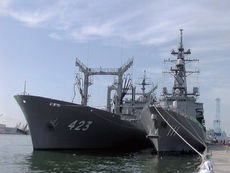
Supply ship Tokiwa (left): The vessel shuttled many times between Dubai, UAE and the minesweeping site about 500 miles away where minesweeper carrier Hayese and 4 other minesweepers continued minesweeping operations off Kuwait. The vessel supplied foods, fuel, fresh water, and letters and luggage from family members sent from Japan to the minesweepers. At the time, mine cans severed from anchoring cable were flowing through the Persian Gulf, and the navigation of the ship was dangerous.
The Persian Gulf Minesweeper Dispatch Unit, which reported directly to the Self-Defense Fleet Commander, was formed and departed on April 26. A total of 511 soldiers commanded by Captain Taosa Ochiai as the commander embarked 6 vessels including minesweeper carrier Hayase, supply ship Tokiwa, minesweepers Hikoshima, Yurishima, Awashima, and Sakushima. The six vessels departed their respective home ports on April 26. The mission was completed on September 11, successfully sweeping 34 mines without any casualties in 99 days of dangerous and difficult work.
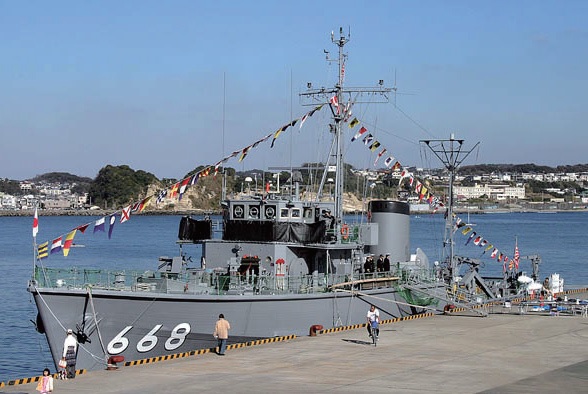
Japan Maritime Self-Defense Force minesweeper “Yurishima” opened to the public on Enoshima, Kanagawa Prefecture on December 23, 2003
According to “Operation Gulf Dawn”, compilation of documentation records by then Captain Taosa Ochiai, T-shirts which depicted national flags of about 30 countries which contributed to the reconstruction of the Gulf were sold as an expression of gratitude for the countries which contributed the Gulf reconstruction. However, the Japanese flag was not included in the T-shirt. It was only in June after the JMSDF minesweeping activities started and the activities were reported in the local media when the Japanese flag was included alongside other national flags depicted in the T-shirts.
Despite giving $ 13 billion in financial assistance during the Gulf War, the Japanese flag did not appear in the full-page advertisement in the Washington Post which Kuwait posted shortly after the end of the Gulf War. After the minesweeper was dispatched, the commemorative stamp issued in Kuwait had the Japanese flag printed along with other countries’ flags.
It was a living testimony of the need for human contributions in dangerous environment in international contributions.
Last but not least, I would like to quote an excerpt from a part of the “Operation Gulf Dawn”.
A press conference was held when our vessels called in Kuwait. After I explained the progress of the minesweeping operation, I was asked a question from a local newspaper reporter.
“The people of Kuwait are really grateful to you. You came to the Persian Gulf with such a small boat from Japan in the Far East across long distance, and you carried out a very dangerous mission of mine removal for us. Thank you very much from the bottom of my heart. For that matter, Japan has not been at war for 45 years since World War II, but why did you say that Japan possesses the most difficult technique of mine sweeping equal to that of the United States, Britain, and France that have experienced multiple wars such as the Vietnam War, the Falkland War, and the Suez War? Was Japan engaged in a secret war?”
I replied as follows.
“No, that is not the case. In March 1945, about 12,000 mines were laid in the sea near Japan, mainly in the Seto Inland Sea, and the Japanese Navy dared to challenge the threat, and its minesweeping work continued after the war. It was eventually taken over by the Japan Maritime Self-Defense Force, and the minesweeping operation was continued until the early 1970’s, in order to ensure the safety of vessel navigation in the waters near Japan. I myself was involved in the minesweeping works when I was younger. The minesweeping unit of Japan, which has been in peace for about 45 years since World War II, is on a par with advanced nations in minesweeping capability because former Navy seniors left a good tradition behind. Thanks to this, and the accumulated efforts of the Japan Maritime Self-Defense Force minesweepers, who took over the duties, have steadily conducted training and refined their skills, it was possible.”
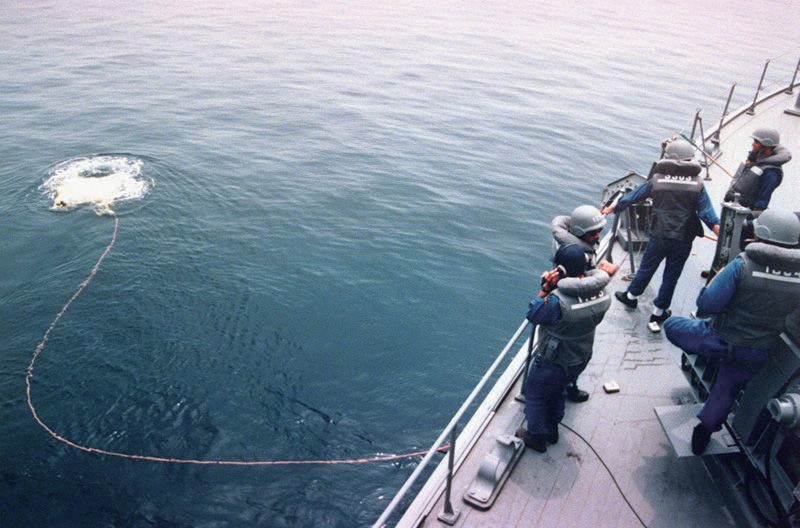
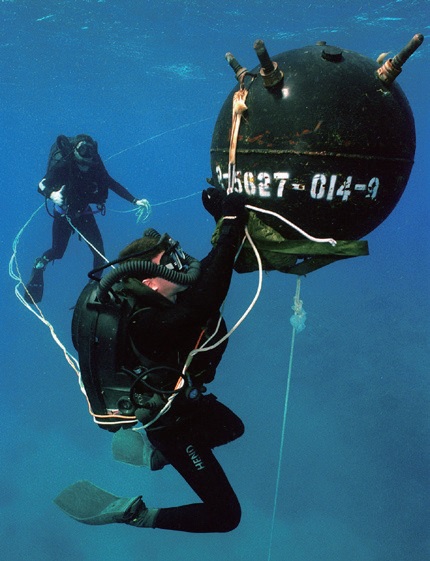 The SDF heading for mine clearance by remote control (June 19, 1991). Underwater disposal squad. Since no underwater television was installed in the vessel, Verification of the target detected by the mine detector had to rely on the underwater disposal personnel to visually confirm that the target was a mine. A courageous execution, backed by advanced technology, was required to approach the mines, attach explosives, and remotely explode them while ensuring safety.
The SDF heading for mine clearance by remote control (June 19, 1991). Underwater disposal squad. Since no underwater television was installed in the vessel, Verification of the target detected by the mine detector had to rely on the underwater disposal personnel to visually confirm that the target was a mine. A courageous execution, backed by advanced technology, was required to approach the mines, attach explosives, and remotely explode them while ensuring safety.

